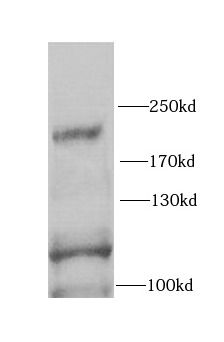Products
ERBB4 antibody
| Synonyms: | Receptor tyrosine-protein kinase erbB-4|Proto-oncogene-like protein c-ErbB-4|Tyrosine kinase-type cell surface receptor HER4|p180erbB4|ERBB4 intracellular domain (4ICD antibody, E4ICD) Alternative names: s80HER4|ERBB4|HER4 antibody | ||
| Catalogue No.: | FNab02829 | Reactivity: | Mouse, Rat |
| Host: | Rabbit | Tested Application: | ELISA, IHC, WB |
| Clonality: | polyclonal | Isotype: | IgG |
| Size | Price |
|---|---|
| 100µg | Inquiry |
- SPECIFICATIONS
- FIGURES
- CONDITIONS
- FAQS
- Product Name
- ERBB4 antibody
- Catalogue No.
- FNab02829
- Size
- 100μg
- Form
- liquid
- Purification
- Immunogen affinity purified
- Purity
- ≥95% as determined by SDS-PAGE
- Clonality
- polyclonal
- Isotype
- IgG
- Storage
- PBS with 0.02% sodium azide and 50% glycerol pH 7.3, -20℃ for 12 months (Avoid repeated freeze / thaw cycles.)
- Immunogen
- v-erb-a erythroblastic leukemia viral oncogene homolog 4 (avian)
- Alternative Names
- Receptor tyrosine-protein kinase erbB-4|Proto-oncogene-like protein c-ErbB-4|Tyrosine kinase-type cell surface receptor HER4|p180erbB4|ERBB4 intracellular domain (4ICD antibody, E4ICD) Alternative names: s80HER4|ERBB4|HER4 antibody
- UniProt ID
- Q15303
- Observed MW
- 180 kDa
- Tested Applications
- ELISA, IHC, WB
- Recommended dilution
- WB: 1:500 - 1:1000; IHC: 1:50 - 1:100
 mouse brain tissue were subjected to SDS PAGE followed by western blot with FNab02829(ERBB4 antibody) at dilution of 1:1000
mouse brain tissue were subjected to SDS PAGE followed by western blot with FNab02829(ERBB4 antibody) at dilution of 1:1000
 Immunohistochemistry of paraffin-embedded rat lung using FNab02829(ERBB4 antibody) at dilution of 1:100
Immunohistochemistry of paraffin-embedded rat lung using FNab02829(ERBB4 antibody) at dilution of 1:100
- Background
- This gene is a member of the Tyr protein kinase family and the epidermal growth factor receptor subfamily. It encodes a single-pass type I membrane protein with multiple cysteine rich domains, a transmembrane domain, a tyrosine kinase domain, a phosphotidylinositol-3 kinase binding site and a PDZ domain binding motif. The protein binds to and is activated by neuregulins and other factors and induces a variety of cellular responses including mitogenesis and differentiation. Multiple proteolytic events allow for the release of a cytoplasmic fragment and an extracellular fragment. Mutations in this gene have been associated with cancer. Alternatively spliced variants which encode different protein isoforms have been described; however, not all variants have been fully characterized.
How many times can antibodies be recycled?
First, usually it's not suggested to recycle antibodies. After use, buffer system of antibodies has changed. The storage condition of recycled antibodies for different customers also varies. Thus, the performance efficiency of recycled antibodies can’t be guaranteed. Besides, FineTest ever conducted the antibody recycling assay. Assay results show recycling times of different antibodies also varies. Usually, higher antibody titer allows more repeated use. Customers can determine based on experimental requirements.
Notes: After incubation, we recycle rest antibodies to centrifuge tube and store at 4℃. High titer antibodies can be stored for a minimum of one week. Reuse about three times.
What are components of FineTest antibody buffer?
Components of FineTest antibody buffer are usually PBS with proclin300 or sodium azide, BSA, 50% glycerol. Common preservative is proclin300 or sodium azide, which is widely applied in the lab and industry.
How about the storage temperature and duration of FineTest antibodies?
Most antibodies are stored at -20℃. Directly-labeled flow cytometry antibodies should be stored at 2 - 8℃. The shelf life is one year. If after sales issues for purchased antibodies appear, return or replacement is available. Usually, antibodies can be still used after the one-year warranty. We can offer technical support services.
Is dilution required for FineTest antibodies? What’s the dilute solution?
Directly-labeled flow cytometry antibodies are ready-to-use without dilution. Other antibodies are usually concentrated. Follow the dilution ratio suggested in the manual. Dilute solution for different experiments also varies. Common antibody dilution buffers are acceptable(e.g. PBST, TBST, antibody blocking buffer).
How to retrieve antibodies for immunohistochemistry?
Common retrieval buffers: Tris-EDTA Buffer(pH 9.0); Citrate Buffer(pH 6.0)
Heat induced antibody retrieval:
Method 1: Water-bath heating: Put the beaker with retrieval buffer and slide in the boiling water bath. Keep the boiling state for 15min. Naturally cool to room temperature;
Method 2: Microwave retrieval: Put the beaker with retrieval buffer and slide in the microwave oven. Heat at high power for 5min, Switch OFF for 3min, Heat at medium power for 5min. Naturally cool to room temperature.
How to choose secondary antibodies?
(1) Secondary antibodies react with primary antibodies. Thus, secondary antibodies should be against host species of primary antibodies. E.g. If the primary antibody is derived from rabbit, the relevant secondary antibody should be against rabbit. E.g. goat anti rabbit or donkey anti rabbit.
(2) Choose secondary antibody conjugates according to the experimental type, e.g. ELISA, WB, IHC etc. Common enzyme conjugated secondary antibodies are labelled by HRP, AP etc. Fluorescin or dye labelled secondary antibodies are applied in immunofluorescence and flow cytometry(e.g. FITC, Cy3).
